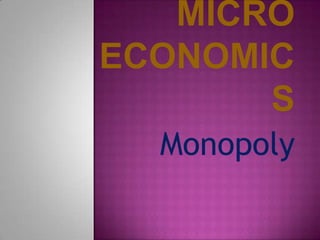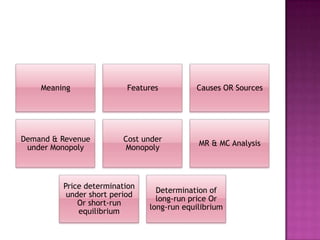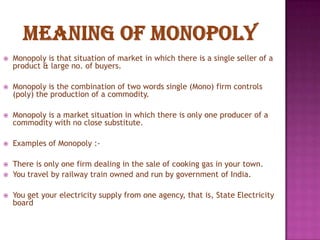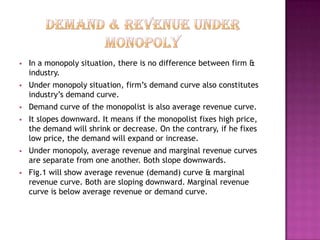Monopoly
- 1. Monopoly
- 2. Meaning Features Causes OR Sources Demand & Revenue under Monopoly Cost under Monopoly MR & MC Analysis Price determination under short period Or short-run equilibrium Determination of long-run price Or long-run equilibrium
- 3. Monopoly is that situation of market in which there is a single seller of a product & large no. of buyers. Monopoly is the combination of two words single (Mono) firm controls (poly) the production of a commodity. Monopoly is a market situation in which there is only one producer of a commodity with no close substitute. Examples of Monopoly :- There is only one firm dealing in the sale of cooking gas in your town. You travel by railway train owned and run by government of India. You get your electricity supply from one agency, that is, State Electricity board
- 4. According to Koutsoyiannis, “Monopoly is a market situation, in which there is a single seller, there are no close substitutes for commodity it produces, there are barriers to entry. “ In the words of prof. ferguson, “A pure monopoly exists when there is only one producer in a market, there is no direct competitors.”
- 5. under Monopoly there should be a one producer of the commodity. He may be a sole proprietor or there may be a group of partners or a joint-stock company or a state. Thus, there is only one firm in monopoly & there is no distinction between firm and industry, but the buyers of product in a large number. :- Under monopoly situation, there is only one firm and the and the difference between firm & industry disappears. :- In the words of J.S.Bains, “A firm assumes monopoly situation when it has no close rival.” There are some restrictions on the entry of new firms into monopoly industry.
- 6. No close substitute :- The commodity produced by the firm should have no close substitute, otherwise the monopolist will not be able to determine the price of his commodity. Price maker :- A monopolist has full control over the supply of the commodity. On the other hand, there are large no. of buyers, but the demand of a single buyer, constitutes only a small portion of the total marker demand. Hence, the buyers have to pay the same price as fixed by the monopolist. In other words, price of the commodity is fully under the control of monopolist. In the case, the monopolist increases the supply of the commodity, the price of it will fall. If he reduces the supply, the price of it will rise.
- 7. a) Control over raw material :- A firm may control the total supply of raw material that is essential in the production of some product. By controlling the key raw material or natural resources a firm can monopolies the industry and keep new competitors out. b) Patents :- A patent is an exclusive right granted by the government to use some productive technique or to produce a certain product. Patents give the sole right to patent holder to produce a particular product. c) Technical barriers :- The technical barriers to entry are also responsible for monopoly. The principal technical barrier is the scale of production. The production of a particular commodity may exhibit decreasing marginal & average cost over a wide range of output levels so that it becomes profitable to produce only at a large scale.
- 8. Government policy :- The government may grant a license Capital size to a firm to have the exclusive privilege to produce a given good or service in a particular area. No firm can enter into that area without a license provided by the government. These licenses is awarded in case of public utility, like electricity, gas, telephones and variety of other situations. :- Monopoly may also be caused due to the huge amount of capital required to establish a particular productive unit. The supply of commodity may involve the use of such a vast amount of capital equipment that new competitors are effectively excluded from entering the market. Business mergers :- the status A firm may acquire monopoly simply by buying out it rivals. It merges with them to get a high combined market share for the new larger firm. Once unified, the former competitors no longer compete with one other & acquire of monopoly.
- 9. In a monopoly situation, there is no difference between firm & industry. Under monopoly situation, firm’s demand curve also constitutes industry’s demand curve. Demand curve of the monopolist is also average revenue curve. It slopes downward. It means if the monopolist fixes high price, the demand will shrink or decrease. On the contrary, if he fixes low price, the demand will expand or increase. Under monopoly, average revenue and marginal revenue curves are separate from one another. Both slope downwards. Fig.1 will show average revenue (demand) curve & marginal revenue curve. Both are sloping downward. Marginal revenue curve is below average revenue or demand curve.















